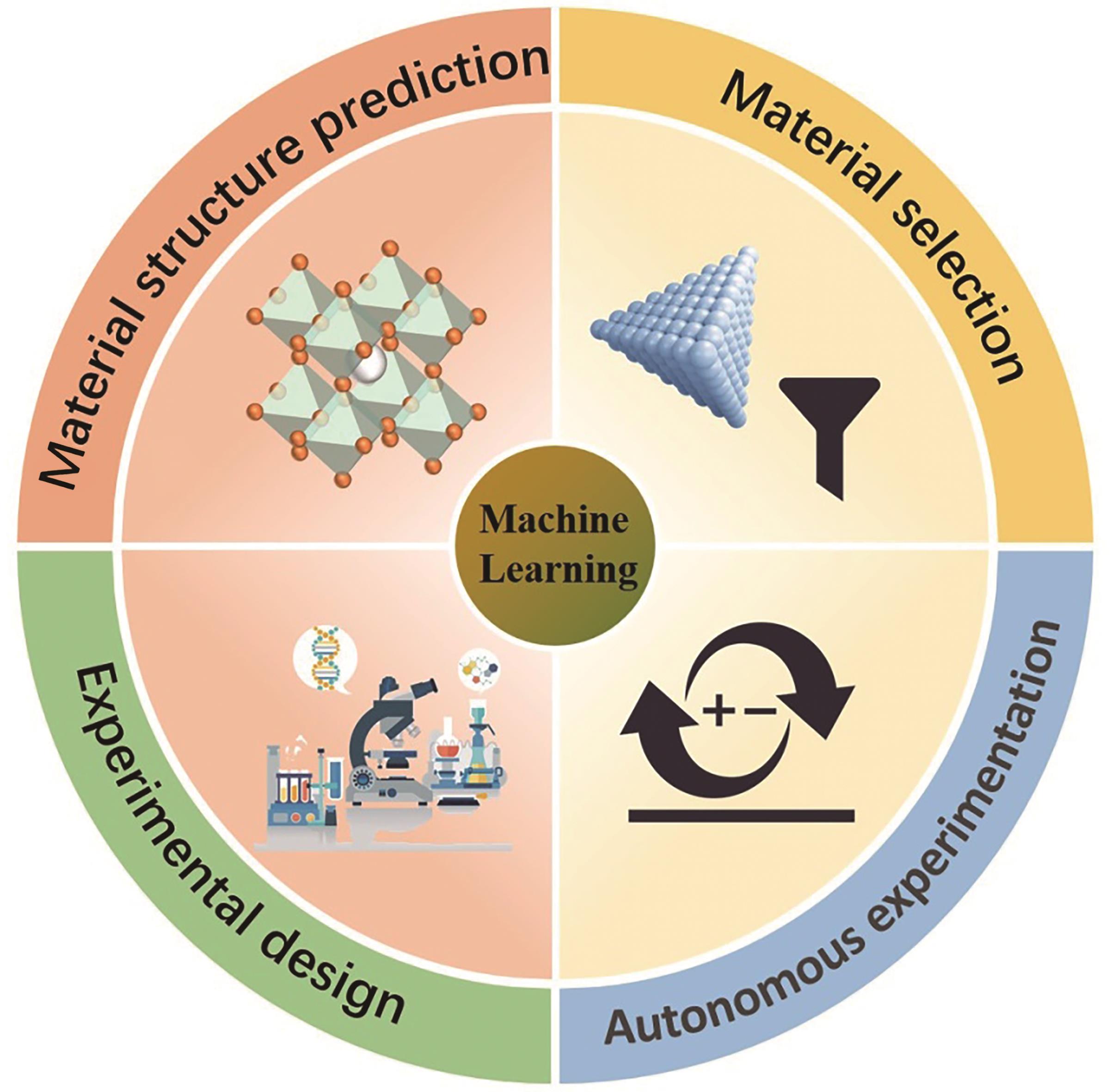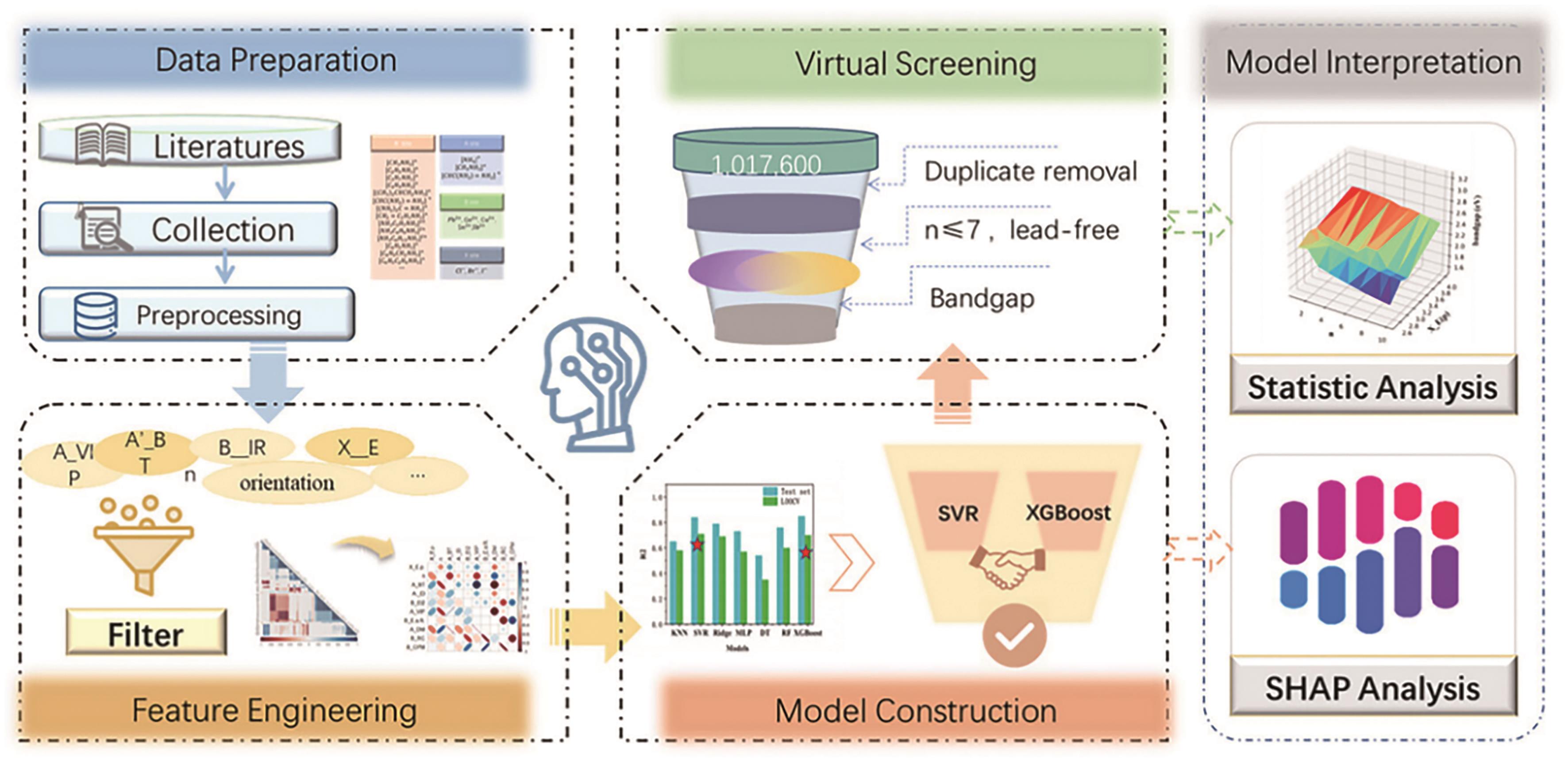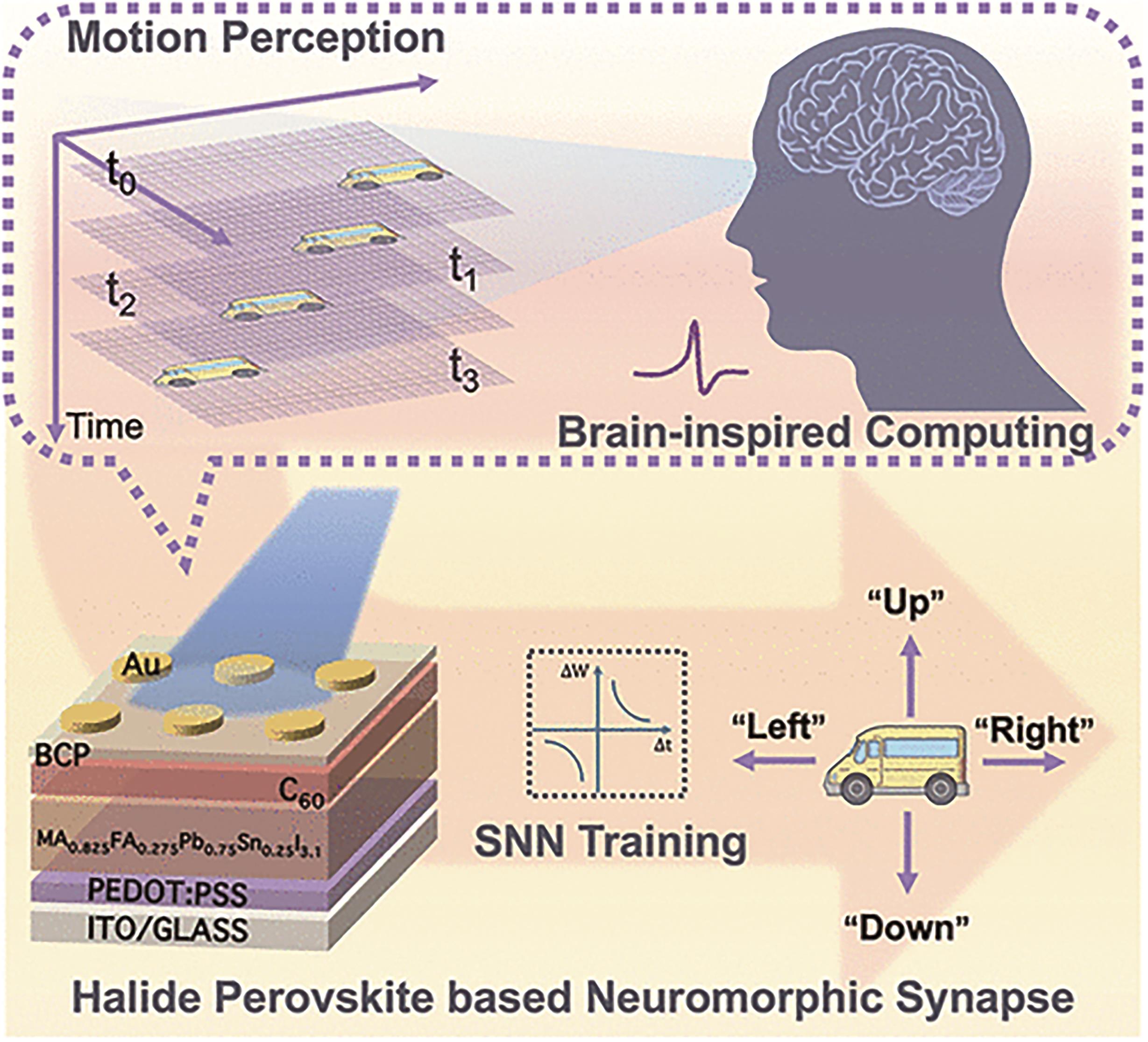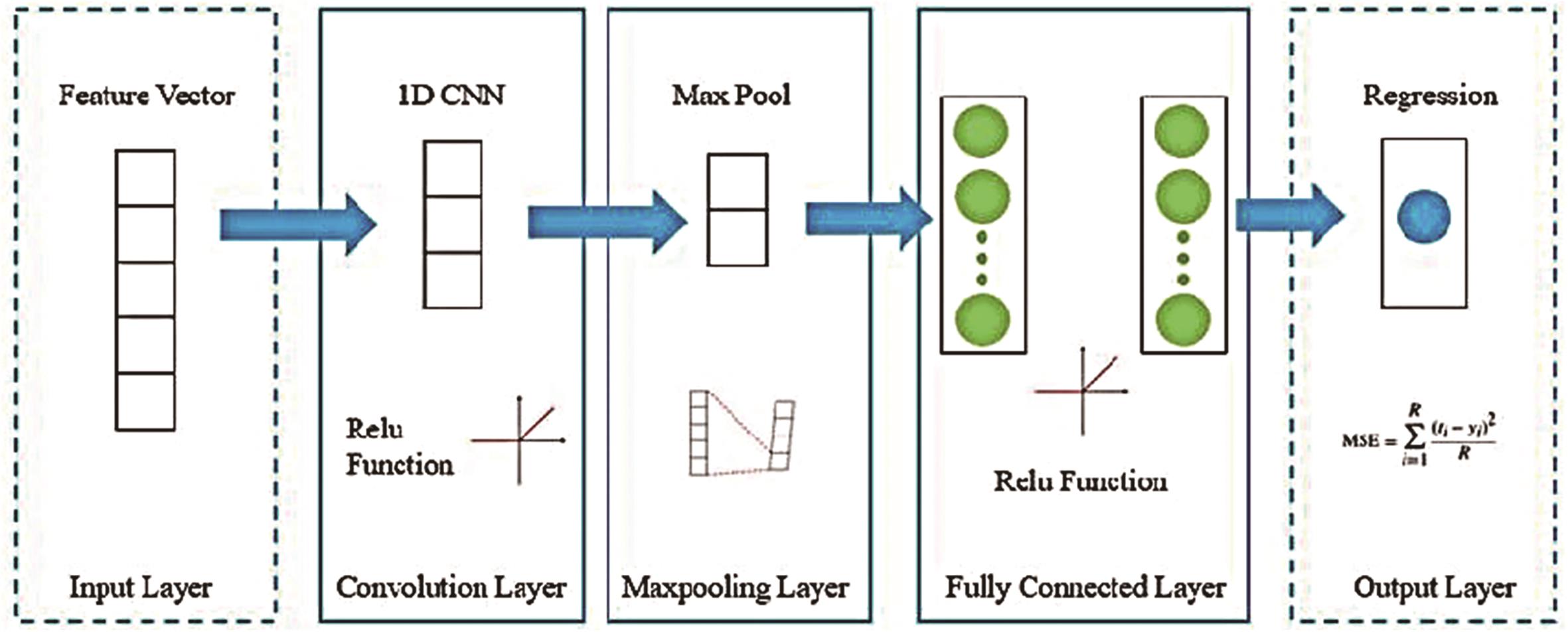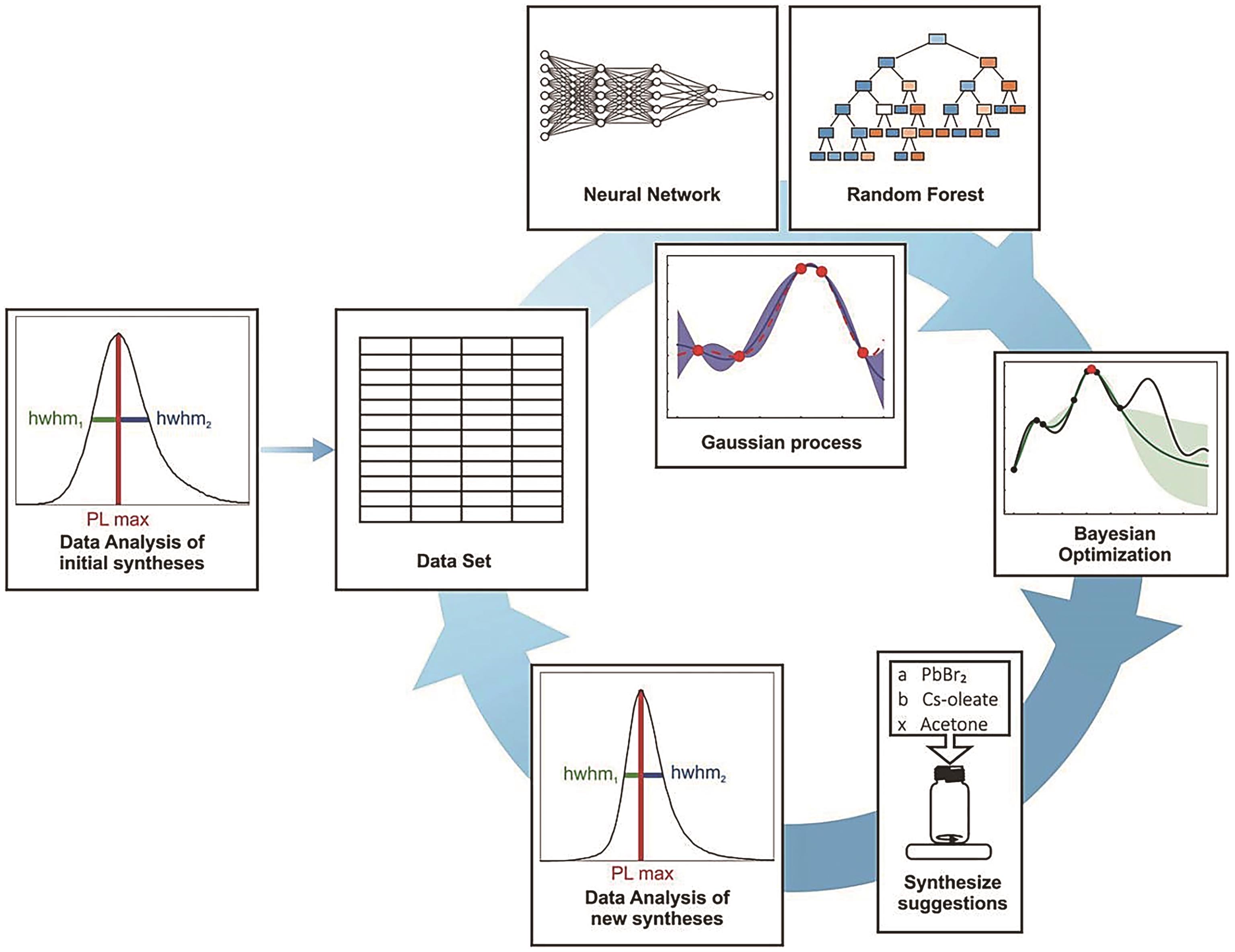
应用化学 ›› 2025, Vol. 42 ›› Issue (6): 757-775.DOI: 10.19894/j.issn.1000-0518.250064
• 综合评述 • 上一篇
机器学习驱动的钙钛矿发光材料研究进展:智能设计、性能优化与产业化应用
王一铭1, 杨博翔2, 张华久3, 孙立恒1( ), 董彪1(
), 董彪1( )
)
- 1.吉林大学电子科学与工程学院,长春 130012
2.吉林大学化学学院,长春 130015
3.长春吉大附中实验学校,长春 130021
-
收稿日期:2025-02-21接受日期:2025-05-11出版日期:2025-06-01发布日期:2025-07-01 -
通讯作者:孙立恒,董彪 -
作者简介:第一联系人:共同第一作者 -
基金资助:国家自然科学基金(52250077);吉林省自然科学基金(20220402005GH);吉林省科技厅项目(20210204095YY)
Research Progress of Machine Learning-Driven Perovskite Luminescent Materials: Intelligent Design, Performance Optimization and Industrial Application
Yi-Ming WANG1, Bo-Xiang YANG2, Hua-Jiu ZHANG3, Li-Heng SUN1( ), Biao DONG1(
), Biao DONG1( )
)
- 1.College of Electronic Science and Engineering,Jilin University,Changchun 130012,China
2.College of Chemistry,Jilin University,Changchun 130015,China
3.Affiliated Middle School to Jilin University,Changchun 130021,China
-
Received:2025-02-21Accepted:2025-05-11Published:2025-06-01Online:2025-07-01 -
Contact:Li-Heng SUN,Biao DONG -
About author:dongb@jlu.edu.cn
sunlh24@jlu.edu.cn
-
Supported by:the National Natural Science Foundation of China(52250077);the Natural Science Foundation of Jilin Province(20220402005GH);Jilin Provincial Department of Science and Technology(20210204095YY)
摘要:
机器学习技术为钙钛矿发光材料的高效开发提供了突破性解决方案。 本文系统综述了该技术在材料设计、性能优化及实验指导中的创新应用,重点解决传统试错法效率低下(如CsPbBr3单组分优化需320次实验,耗时14个月)与理论计算精度不足(如传统密度泛函理论(DFT)对Eu3+掺杂体系发光效率预测误差达40%)的瓶颈问题。 在材料结构与性能预测方面,基于神经网络的跨尺度建模显著提升了关键参数的预测精度。 开发的深度卷积神经网络(CNN)模型,通过128×128×128电子密度网格解析晶体畸变,实现带隙预测平均绝对误差(MAE)0.08 eV,对CsPbBr3的预测误差仅1.3%。 图神经网络(GNN)进一步量化层状钙钛矿堆垛角度与带隙的关联,预测误差<0.05 eV; 材料筛选与优化中,多目标算法实现了性能指标的协同提升。 采用NSGA-II算法筛选出Cs2SnGeI6,其外量子效率(EQE)达24%,器件寿命(T??)延长至1200 h。 贝叶斯优化 (Bayesian optimization, BO) 框架结合机器人平台,将CsPbBr3-x I x 量子点的光致发光量子产率(PLQY)从45%提升至89%,实验迭代次数减少85%; 实验设计方面,微流控机器人平台通过动态参数调控(流速10~100 μL/min,混合时间110 s),24 h内筛选出CsPbBr1.5I1.5最佳配比,发射波长误差±3 nm,PLQY达92%。 柔性器件工艺优化中,贝叶斯算法将光电转换效率(PCE)从18.2%提升至21.5%,工艺时间缩短62.5%。
中图分类号:
引用本文
王一铭, 杨博翔, 张华久, 孙立恒, 董彪. 机器学习驱动的钙钛矿发光材料研究进展:智能设计、性能优化与产业化应用[J]. 应用化学, 2025, 42(6): 757-775.
Yi-Ming WANG, Bo-Xiang YANG, Hua-Jiu ZHANG, Li-Heng SUN, Biao DONG. Research Progress of Machine Learning-Driven Perovskite Luminescent Materials: Intelligent Design, Performance Optimization and Industrial Application[J]. Chinese Journal of Applied Chemistry, 2025, 42(6): 757-775.
使用本文
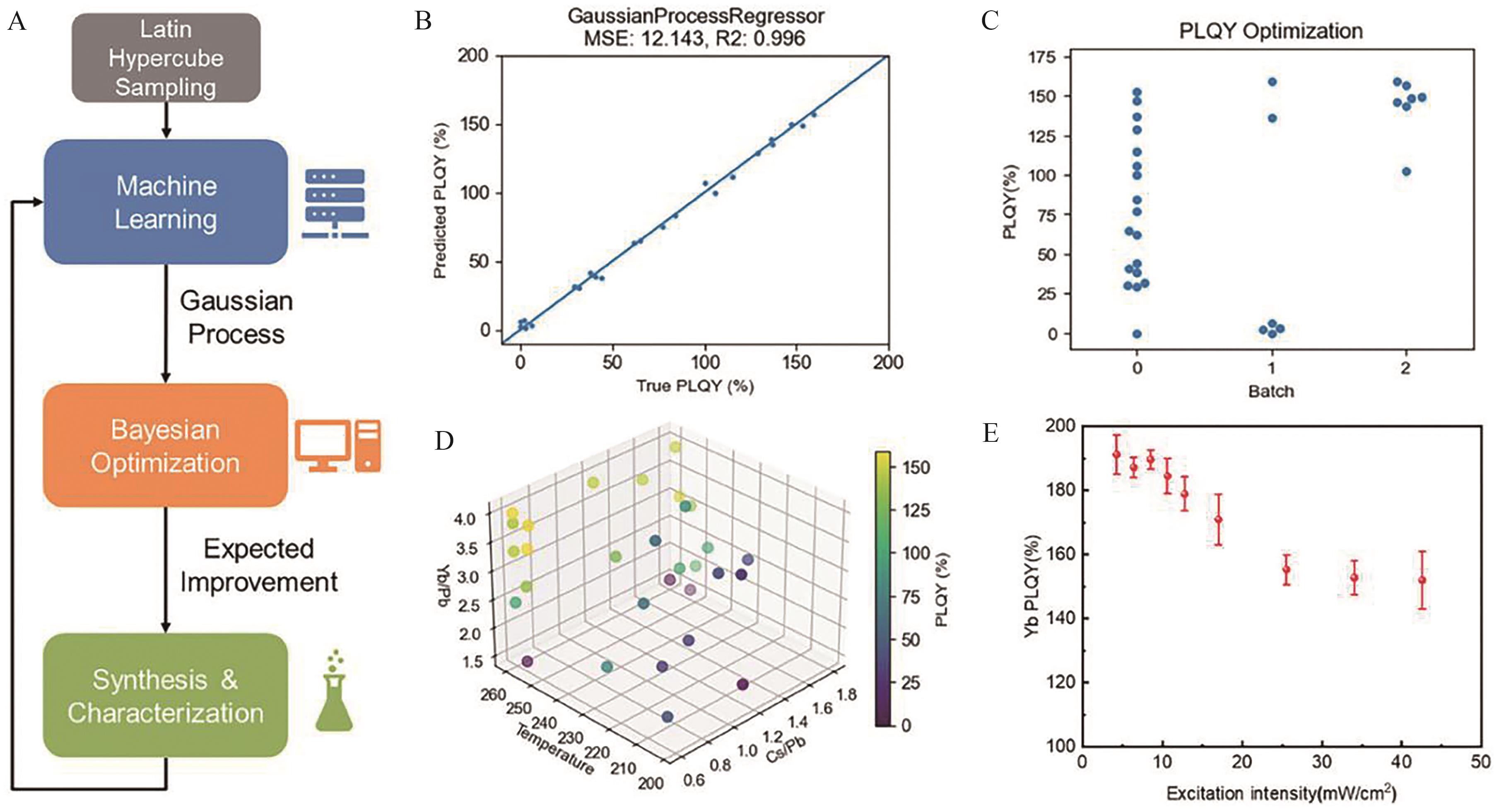
图4 (A)用于优化PLQY的ML(机器学习)和BO(贝叶斯优化)机器学习流程图; (B)第一次迭代后高斯过程回归器的模型精度,取24个数据点,报告MSE和R2得分; (C)在BO的2次迭代中PLQY作为群图的演变,每个批次的最佳值如上所示; (D) Yb/Pb、温度和Cs/Pb变量的三维散点图,以PLQY值着色。 在左上角报告的最高PLQY值对应于高Yb和高温; (E) BO对优化后的Yb掺杂CsPbCl3 纳米晶样品的功率相关PLQY测量[37]
Fig.4 (A) Flowchart of the ML(Machine learning) and BO (Bayesian optimization) machine learning processes used to optimize PLQY; (B) Model accuracy of the Gaussian process regressor after the first iteration, taking 24 data points and reporting the MSE and R2 scores; (C) Evolution of PLQY as a cluster plot over 2 iterations of BO, with optimal values for each batch shown above; (D) 3D scatterplot of the Yb/Pb, temperature, and Cs/Pb variables, with the PLQY values coloring. The highest PLQY values reported in the upper left corner correspond to high Yb and high temperatures; (E) Power-dependent PLQY measurements by BO on optimized Yb-doped CsPbCl3 nanocrystalline samples[37]
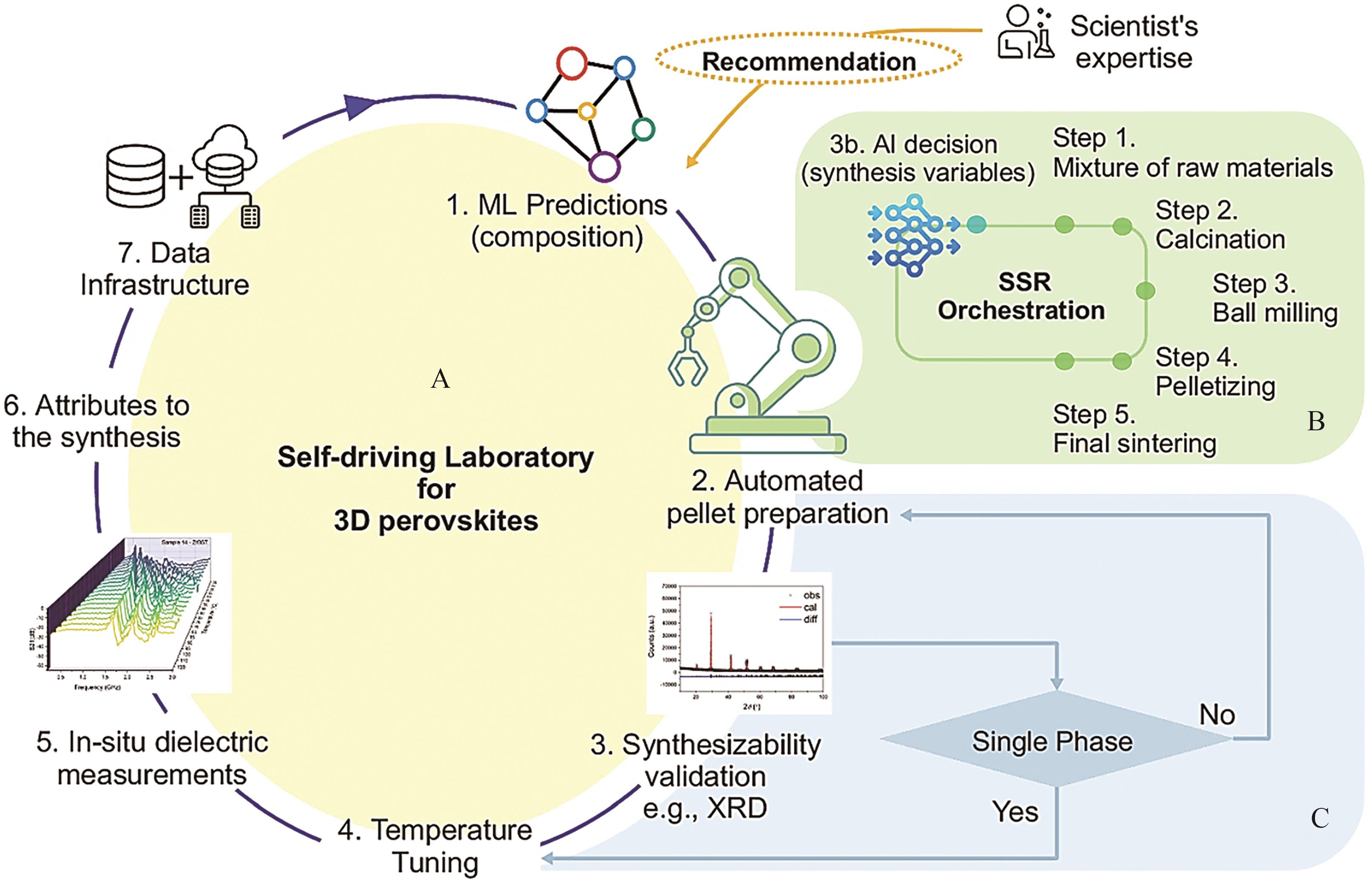
图6 利用机器学习加速钙钛矿固溶体的发现和可持续合成的实验流程图[46]
Fig.6 Experimental flowchart for accelerating the discovery and sustainable synthesis of perovskite solid solutions using machine learning[46]
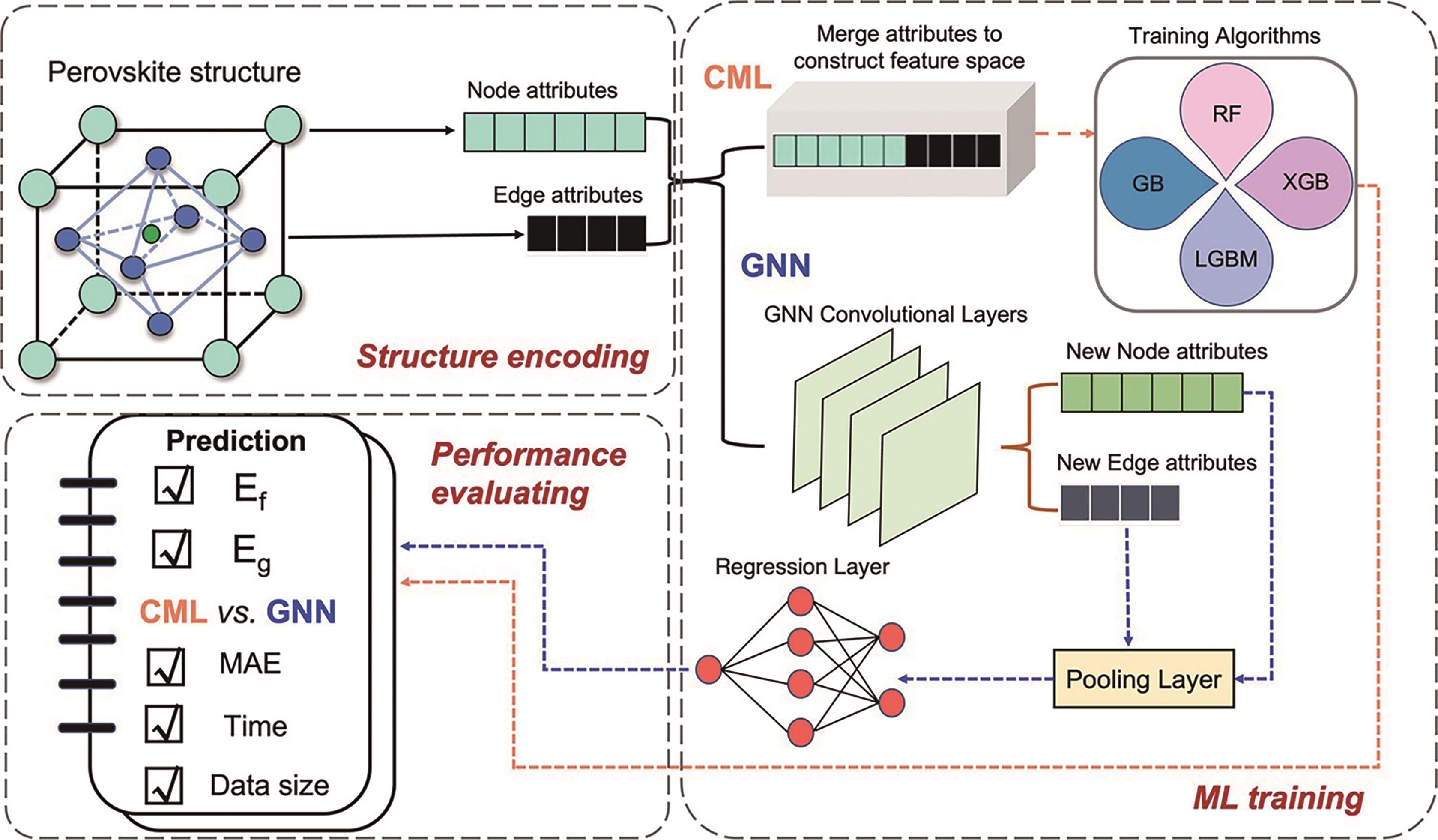
图8 传统机器学习和基于图神经网络模型的训练机制以及二者的对比[55]
Fig.8 Training mechanisms for traditional machine learning and graph neural network based models and a comparison of the two[55]
| 1 | ZHUO Y, BRGOCH J. Opportunities for next-generation luminescent materials through artificial intelligence[J]. J Phys Chem Lett, 2021, 12(2): 764-772. |
| 2 | ANAND D V, XU Q, WEE J, et al. Topological feature engineering for machine learning based halide perovskite materials design[J]. NPJ Comput Mater, 2022, 8(1) : 203-210. |
| 3 | LEITE M. Tackling instability in perovskite solar cells through machine learning[J]. NSF, 2020, 10(39): 33144-33152. |
| 4 | 张润, 战宏梅, 赵晨阳, 等. 含氟膦氧衍生物修饰的纯蓝光钙钛矿发光二极管[J]. 应用化学, 2024, 41(6): 830-838. |
| ZHANG R, ZHAN H M, ZHAO C Y, et al. Pure blue perovskite light‑emitting diodes modified with fluorine‑containing phosphine oxide derivatives[J]. Chin J Appl Chem, 2024, 41(6): 830-838. | |
| 5 | LI M, LIU Y, DUAN R, et al. Aromatic-imide-based thermally activated delayed fluorescence materials for highly efficient organic light-emitting diodes[J]. Angew Chem Int Ed, 2017, 56(30): 8818-8822. |
| 6 | SHENG M, ZHU H, WANG S, et al. Accelerated discovery of halide perovskite materials via computational methods: a review[J]. Nanomaterials, 2024, 14(13): 1176-1183. |
| 7 | BAI Z, BHULLAR M, AKINPELU A, et al. Unveiling future superconductors through machine learning[J]. Mater Today Phys, 2024, 43(24): 231-242. |
| 8 | 孟竞佳, 张峰, 任艳东, 等. 钙钛矿二维纳米材料的合成和发光研究进展[J]. 应用化学, 2018, 35(3): 342-350. |
| MENG J J, ZHANG F, REN Y D, et al. Halide perovskite based two-dimensional nanocrystals:synthesis and luminescence properties[J]. Chin J Appl Chem, 2018, 35(3): 342-350. | |
| 9 | JIANG L, JIANG X, LV G, et al. A mini review of machine learning in inorganic phosphors[J]. J Mater Inform, 2022, 2(3) : 434-442. |
| 10 | HARTONO N T P, KOEBLER H, GRANIERO P, et al. Stability follows efficiency based on the analysis of a large perovskite solar cells ageing dataset[J]. Nat Commun, 2023, 14(1) :356-365. |
| 11 | BARAI V L, DHOBLE S J. Prediction of excitation wavelength of phosphors by using machine learning model[J]. J Lumin, 2019, 208: 437-442. |
| 12 | KIM K, KANG S, YOO J, et al. Deep-learning-based inverse design model for intelligent discovery of organic molecules[J]. NPJ Comput Mater, 2018, 4(1): 465-473. |
| 13 | DEQUILETTES D W, VORPAHL S M, STRANKS S D, et al. Impact of microstructure on local carrier lifetime in perovskite solar cells[J]. Science, 2015, 348(6235): 683-686. |
| 14 | MAKAROV N S, GUO S J, ISAIENKO O, et al. Spectral and dynamical properties of single excitons, biexcitons, and trions in cesium-lead-halide perovskite quantum dots[J]. Nano Lett, 2016, 16(4): 2349-2362. |
| 15 | LIN K B, XING J, QUAN L N, et al. Perovskite light-emitting diodes with external quantum efficiency exceeding 20 percent[J]. Nature, 2018, 562(7726): 245-252. |
| 16 | LONG Z W, YANG S, PI J C, et al. All-inorganic halide perovskite (CsPbX3, X=Cl, Br, I) quantum dots synthesized via fast anion hot injection by using trimethylhalosilanes[J]. Ceramics Int, 2022, 48(23): 35474-35479. |
| 17 | AZAR M H, MOHAMMADI M, REZAEI N T, et al. Effect of silica encapsulation on the stability and photoluminescence emission of FAPbI3 nanocrystals for white-light-emitting perovskite diodes[J]. J Alloys Comp, 2022, 907(8): 768-772. |
| 18 | SUTHERLAND B R, HOOGLAND S, ADACHI M M, et al. Perovskite thin films via atomic layer deposition[J]. Adv Mater, 2015, 27(1): 53-58. |
| 19 | YU Y, ZHOU W, LI C, et al. Tb3+and Bi3+ Co-doping of lead-free Cs2NaInCl6 double perovskite nanocrystals for tailoring optical properties[J]. Nanomaterials, 2023, 13(3): 9-13. |
| 20 | YIN Y, JIN J X, REN G P, et al. Accelerated room temperature synthesis of desired cesium lead halide perovskite nanocrystals via automated microfluidic meta learner[J]. Chem Eng Sci, 2023, 28(2): 282-289. |
| 21 | 黄国斌, 骆登峰, 张茂升. 多色高发光效率CsPbX3(X=Cl,Br,I)钙钛矿量子点的制备及其在发光二极管中的应用[J]. 应用化学, 2019, 36(8): 932-938. |
| HUANG G B, LUO D F, ZHANG M S. Preparation of CsPbX3(X=Cl,Br,I) perovskite quantum dots with multicolor and high luminescence efficiency and its application in light emitting diode devices[J]. Chin J Appl Chem, 2019, 36(8): 932-938. | |
| 22 | LIU X, TONG Y, WANG Q, et al. The direct water quenching process in the preparation of broad wavelength tunable CsPb(Br/I)3 NCs@glass for backlight display[J]. Mater Today Nano, 2023, 21(1): 276-285. |
| 23 | XU F, CHEN D, HUANG D, et al. Suppression of photoinduced phase segregation in mixed-halide perovskite nanocrystals for stable light-emitting diodes[J]. J Phys Chem Lett, 2022, 13(2): 718-725. |
| 24 | BI C, WANG S, WEN W, et al. Room-temperature construction of mixed-halide perovskite quantum dots with high photoluminescence quantum yield[J]. J Phys Chem C, 2018, 122(9): 5151-5160. |
| 25 | ZHANG Y, GUO N, SHAO B, et al. Photoluminescence and optical temperature measurement of Mn4+/Er3+ co-activated double perovskite phosphor through site-advantageous occupation[J]. Spectrochim Acta Part A-Mol Biomol Spectrosc, 2021, 16(2): 259-267. |
| 26 | WANG C, LI Y, LV Q, et al. Te4+/Bi3+ co-doped double perovskites with tunable dual-emission for contactless light sensor, encrypted information transmission and white light emitting diodes[J]. Chem Eng J, 2022, 17(5): 431-439. |
| 27 | VALSALAKUMAR S Z. Advancing carbon-based perovskite solar cells: experimental validation, optimization, and machine learning integration[D]. England: University of Exeter, 2024. |
| 28 | NUKUNUDOMPANICH M, YOON H, HYOJAE L, et al. Machine learning of properties of lead-free perovskites with a neural network with additive kernel regression-based neuron activation functions[J]. MRS Adv, 2024, 9(11): 857-862. |
| 29 | SHEN Y, WANG J, JI X, et al. Machine learning-assisted discovery of 2D perovskites with tailored bandgap for solar cells[J]. Adv Theory Simulat, 2023, 6(6): 876-882. |
| 30 | TIAN T, LI T, LI G, et al. Bandgap prediction of ABX3-type perovskites using broad learning system[J]. Mater Today Commun, 2023, 5(6): 37-43. |
| 31 | AGGARWAL S, JAYAM B, MAITI T. Data-driven approach to accelerate the design of halide perovskite for photovoltaic application using electronic properties as descriptors[J]. Energy Technol, 2024, 12(4): 534-541. |
| 32 | LIU S, WU Z, HE Z, et al. Low-power perovskite neuromorphic synapse with enhanced photon efficiency for directional motion perception[J]. ACS Appl Mater Interfaces, 2024, 16(17): 22303-22311. |
| 33 | OMPRAKASH P, MANIKANDAN B, SANDEEP A, et al. Graph representational learning for bandgap prediction in varied perovskite crystals[J]. Computat Mater Sci, 2021, 15(17): 196-203. |
| 34 | CHENEBUAH E T, NGANBE M, TCHAGANG A B. Comparative analysis of machine learning approaches on the prediction of the electronic properties of perovskites: a case study of ABX3 and A2BB'X6[J]. Mater Today Commun, 2021, 16(7): 27-35. |
| 35 | SHRIVASTAV N, MADAN J, PANDEY R. Predicting photovoltaic efficiency in Cs-based perovskite solar cells: a comprehensive study integrating SCAPS simulation and machine learning models[J]. Solid State Commun, 2024, 380(1): 8-15. |
| 36 | ZHANG H, CHENG Z Y, ZHANG Y J, et al. Improved luminescence properties and thermal stability of SrSi2O2N2∶Eu2+ phosphor with single phase via the formation of Eu3+ on surface structure[J]. J Mater Sci, 2017, 52(12): 7605-7614. |
| 37 | JING Y, LOW A K Y, LIU Y, et al. Stable and highly emissive infrared Yb-doped perovskite quantum cutters engineered by machine learning[J]. Adv Mater, 2024, 36(44): 87-94. |
| 38 | LUO Q, HAO H, LIU H. Deep learning based on small sample dataset: prediction of dielectric properties of SrTiO3-type perovskite with doping modification[J]. Royal Soc Open Sci, 2024, 11(5): 2839-2846. |
| 39 | LIU W, MENG N, HUO X, et al. Machine learning enables intelligent screening of interface materials towards minimizing voltage losses for p-i-n type perovskite solar cells[J]. J Energy Chem, 2023, 83(1): 128-137. |
| 40 | ZHANG Z, LIU S, XIONG Q, et al. Strategic integration of machine learning in the design of excellent hybrid perovskite solar cells[J]. J Phys Chem Lett, 2025, 16(3): 738-746. |
| 41 | ZHANG Z, ZHANG Y, LIU S. Integrative approach of machine learning and symbolic regression for stability prediction of multicomponent perovskite oxides and high-throughput screening[J]. Comput Mater Sci, 2024, 16(3): 236-247. |
| 42 | CAI Z H, KUBICEK M, FLEIG J, et al. Chemical heterogeneities on La0.6Sr0.4CoO3- δ thin films-correlations to cathode surface activity and stability[J]. Chem Mater, 2012, 24(6): 1116-1127. |
| 43 | MISHRA P, ZHANG M, KAR M, et al. Synthesis of machine learning-predicted Cs2PbSnI6 double perovskite nanocrystals[J]. ACS Nano, 2025, 72(5): 682-691. |
| 44 | ANAND A, KUMARI P, KALYANI A K. High throughput screening of new piezoelectric materials using graph machine learning and knowledge graph approach[J]. Comput Mater Sci, 2025, 246(1): 113445. |
| 45 | FANG X, CHEN Z, MA Q, et al. A2BB'X6/ABX3-type high-performance perovskites screening based on ensemble learning and high throughput screening[J]. Solar Energy, 2023, 12(9): 262-269. |
| 46 | OMIDVAR M, ZHANG H, IHALAGE A A, et al. Accelerated discovery of perovskite solid solutions through automated materials synthesis and characterization[J]. Nat Commun, 2024, 15(1): 5839-5847. |
| 47 | LAMPE C, KOUROUDIS I, HARTH M, et al. Rapid data-efficient optimization of perovskite nanocrystal syntheses through machine learning algorithm fusion[J]. Adv Mater, 2023, 35(16): 970-979. |
| 48 | XU W, LIU Z, PIPER R T, et al. Bayesian optimization of photonic curing process for flexible perovskite photovoltaic devices[J]. Solar Energy Mater Solar Cells, 2023, 12(1): 249-258. |
| 49 | ZHANG J, LIU B, LIU Z, et al. Optimizing perovskite thin-film parameter spaces with machine learning-guided robotic platform for high-performance perovskite solar cells[J]. Adv Energy Mater, 2023, 12(2): 986-991. |
| 50 | HIGGINS K, ZIATDINOV M, KALININ S V, et al. High-throughput study of antisolvents on the stability of multicomponent metal halide perovskites through robotics-based synthesis and machine learning approaches[J]. J Am Chem Soc, 2021, 143(47): 19945-19955. |
| 51 | LIU H, CHEN Z, ZHANG Y, et al. Bayesian reverse design of high-efficiency perovskite solar cells based on experimental knowledge constraints[J]. Appl Phys Lett, 2024, 125(6): 693-699. |
| 52 | CHAKAR J, JULIEN A, MEDJOUBI K, et al. Advanced characterization and degradation analysis of perovskite solar cells using machine learning and bayesian optimization[Z]. 2023 IEEE 50th Photovoltaic Specialists Conference, PVSC. 2023.10.1109/PVSC48320.2023, 10(35): 9877-9882. |
| 53 | SHEN H, WU J, CHEN Z, et al. First-principles study combined with interpretable machine-learning models of bayesian optimization for the design of ultrawide bandgap double perovskites[J]. J Phys Chem C, 2023, 127(43): 21410-21422. |
| 54 | HSU J W P, XU W. Accelerate process optimization in perovskite solar cell manufacturing with machine learning[J]. Matter, 2022, 5(5): 1334-1336. |
| 55 | JIN J, FARAJI S, LIU B, et al. Comparative analysis of conventional machine learning and graph neural network models for perovskite property prediction[J]. Physl Chem C, 2024, 128(39): 16672-16683. |
| 56 | YANG J, MANGANARIS P, MANNODI-KANAKKITHODI A. Discovering novel halide perovskite alloys using multi-fidelity machine learning and genetic algorithm[J]. J Chem Phys, 2024, 160(6): 7932-7937. |
| 57 | CERASOLI F T, DONADIO D. Effective optimization of atomic decoration in giant and superstructurally ordered crystals with machine learning[J]. J Chem Phys, 2024, 161(4): 6849-6856. |
| 58 | DEAN J, SCHEFFLER M, PURCELL T A R, et al. Interpretable machine learning for materials design[J]. J Mater Res, 2023, 38(20): 4477-4496. |
| 59 | EREMIN R A, HUMONEN I S, KAZAKOV A A, et al. Graph neural networks for predicting structural stability of Cd- and Zn-doped γ-CsPbI3[J]. Comput Mater Sci, 2023, 232(1): 1-10. |
| 60 | XU C, DENG X, YU P. High-throughput computational study and machine learning prediction of electronic properties in transition metal dichalcogenide/two-dimensional layered halide perovskite heterostructures[J]. ACS Appl Mater Interfaces, 2024, 16(41): 55970-55980. |
| 61 | KUMAR S, THIYYAKKANDY J, YADAV A K, et al. Comprehensive modeling of high-performance all-inorganic Cs2TiBr6-based perovskite solar cells[J]. Phys Status Solidi B-Basic Solid State Phys, 2024, 261(9): 10-19. |
| [1] | 李文杰, 王利雪, 孙令辉, 游伟, 赵雅彬. 基质辅助激光解吸电离质谱成像在指纹分析中的研究进展[J]. 应用化学, 2020, 37(10): 1137-1146. |
| [2] | 庞浩, 廖兵, 黄玉惠, 从广民. 聚(1,2-亚丙基碳酸酯)的应用研究新进展[J]. 应用化学, 2001, 18(5): 347-350. |
| 阅读次数 | ||||||||||||||||||||||||||||||||||||||||||||||||||
|
全文 66
|
|
|||||||||||||||||||||||||||||||||||||||||||||||||
|
摘要 113
|
|
|||||||||||||||||||||||||||||||||||||||||||||||||
